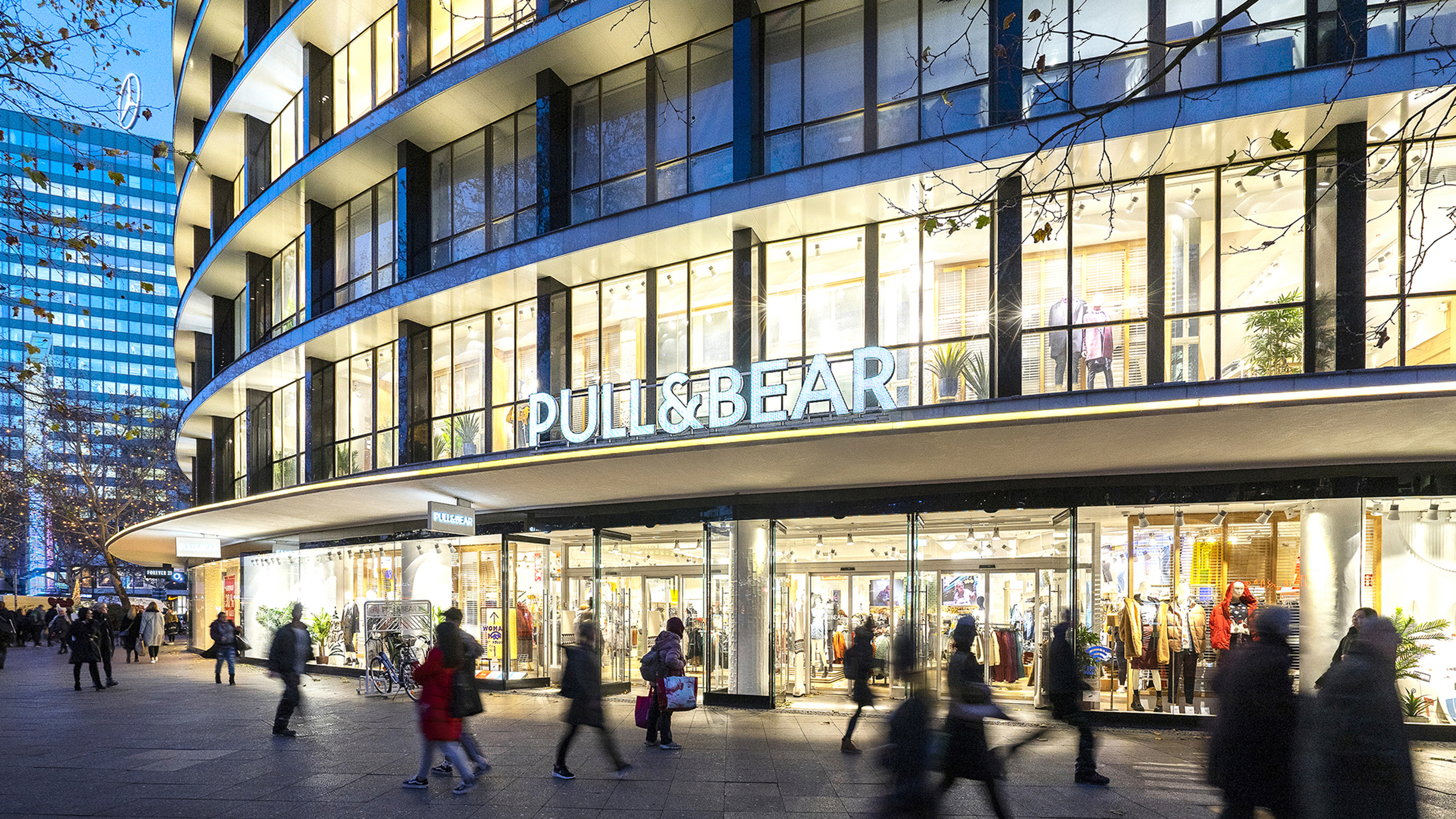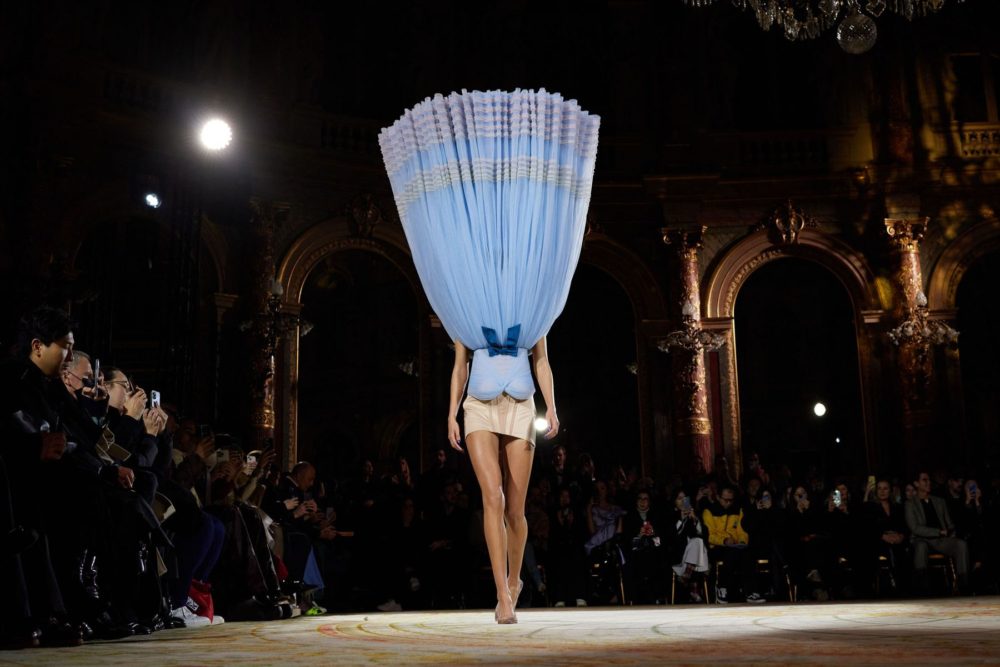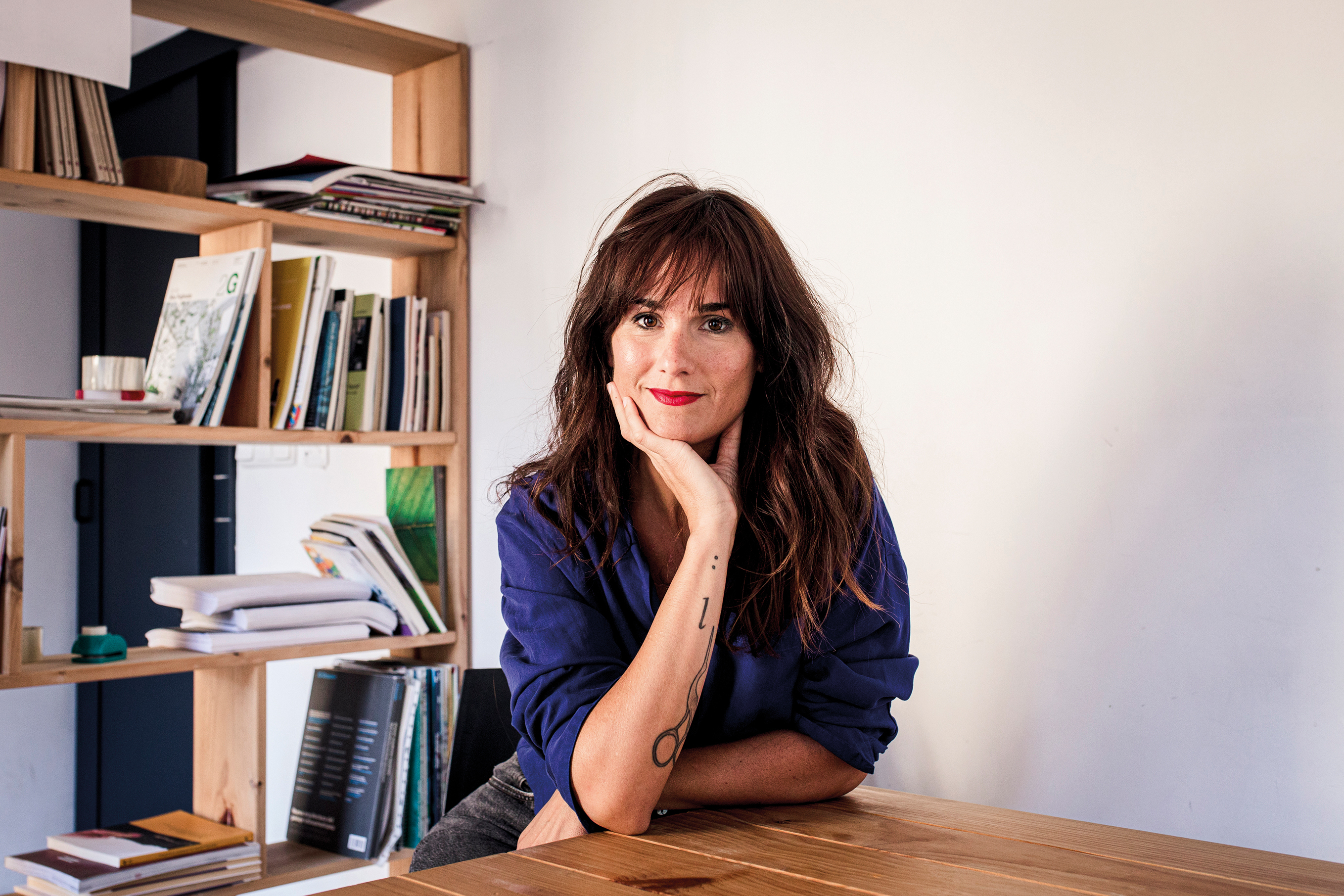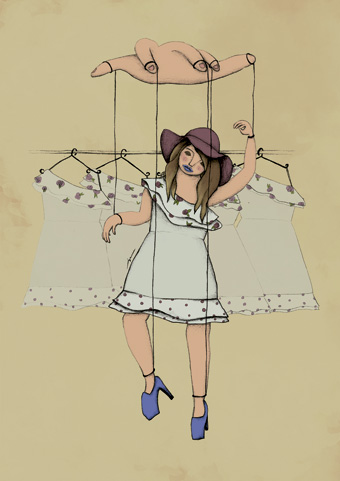"I'm independent, I don't want to get into the fashion industry."
- She's a designer. However, its goal is none other than that of fashion. A sustainable fashion is made by her, an artist born in Finland who lives rooted in our own.
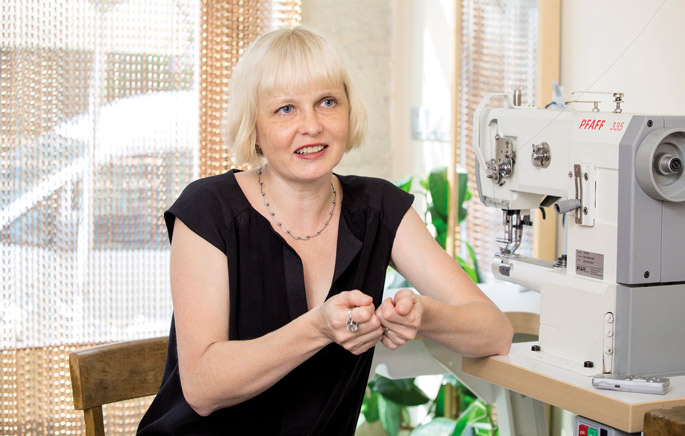
You are a fashion designer and plastic artist, and I don’t know if they are not two sides of the same coin…
Creativity encompasses the two factories, both functions. I'm a fashion designer, yes, but mostly a sustainable fashion designer, and that's what characterizes me, not fashion, not design, sustainable design. However, I feel more connected to design and art than to fashion. I've spent my life creating things with my own hands. On the other hand, I studied first in the craft school and then in college, for seven years, in Finland, and in their design schools they offer great importance and time to any kind of design, from furniture design to dishes... And there's never going to be an art subject, there's always going to be some art subject: art techniques, art history, design… I think that's why I have the ability to make art, that's why I make art, even though my official title is a fashion designer.
In the end-of-study project, you made a felt coat made of carded wool from Finland.
Yes, that's what I did, but after all, the felt that had the way of making the sculpture, I proposed working it by hand. Since I was young, I have brought the ability to work the materials by hand. In the snow, for example, I was working on that, on making sculptures. Snow, in fact, is very easy to shape. Also at home, my mother offered me different materials, and I was walking around, sewing, embroidering, tying… Grandma was always in that, always had something in her hands: crochet, dot… We had crafts artists around us. There was such an atmosphere. My mother, for her part, soon realized my ease and pushed into me the path of creativity. I would say it comes from within. The word vocational is appropriate for the case.
We've also read you're an Ecodesigner.
That's a very broad subject, and I don't know where to start. There's a lot going into the ecosystem, and I, for example, do upcycling. I take something that is worthless – whether it’s straps, secondhand fabrics – and I do something new. As far as I am concerned, I always remember the social perspective. I mean, I myself do what we produce. Sometimes I'm going to work with a cooperative, I'm going to work with nobody, but I have my collaborators next to me, in the neighborhood. I use the concept “zero kilometer”: I don’t have to use the means of transport, I walk, I come on foot, I do the products in my studio, without sending them out. The raw material is always organic.
Where does that way of doing things come from, the concept you use?
The movement began to expand in the 1980s. Over the past five years, it has spread a lot. Twenty years ago, I did my first ecodesign. Until then, I worked with second-hand fabrics or industrial waste. I've been working this way for a long time, but that way of working also needs a name, and they've given it the name of "sustainable fashion." Also “ecological fashion”.
In the shop windows of some shops I have seen industrial waste shelters.
Industry is also present in this world, yes. I am an artisan, but I see many companies working in the area of organic fashion. It is often not possible to distinguish whether or not this is an eco-friendly or sustainable fashion. The industry is using a very sophisticated and technological material to make ecological fashion. For example, a known material: cotton. The sustainable fashion designer is not a cotton fan. In fact, he knows that the processing of cotton is very polluting: water is needed, stack in the process; not a few pesticides; the working conditions of the workers are scarce. The use of cotton in this way is totally prohibited. If you want to use cotton, you must be certified.
As for the dress, what materials would we have more suitable?
Well, right now, polyester is the most environmentally friendly material. I don't like it very much, because it doesn't sweat, and that's not going to be good for anybody's body. However, there are polyesters of different quality. In the shops you see a lot of clothes made of polyester. Cotton is also there, as I said, but it is not environmentally friendly in cotton. It comes from India, or from Pakistan. However, whether or not it is a sustainable fashion, no one is free from sin. It is very difficult to avoid the trap.
Is there greater sensitivity in the countries of northern Europe to sustainable fashion and eco-design?
I don't know. It is true that I was concerned in Finland, but the awareness of the countries of Northern Europe and the rest is also a topic. Here I've met very conscious people. Do not think that everyone in Finland is aware too! There too, as here, some yes and others do not. However, I would say that there is a great movement in Finland to look after the environment. We've been taught this from a young age. For example, when we were still kids, the snow was starting to melt, the teachers were taking us into the forest every spring, cleaning up the forest, collecting the trash. They wanted to teach us that even though the snow covered the dirt, you couldn't throw away the trash. It seems to me a very interesting exercise for children to learn…
In sustainable fashion, you make clothes, you open them, you offer them, you offer art exhibitions.
I do everything, yes. At one time I did no more than art, but soon I also started making products and working in the theater, obviously wearing dresses. It seems to me to be a perfect combination.
How do we dress here?
If we compare ourselves with Finland, well, much better! Anyway, there are a lot more notable tribes: in one heavys, in the other… They say if we dress here in dark, and everyone else, but anywhere it is the same, it is globalized. Because of the dark color, for example, the product that I most sell is black. When someone has to decide, choose black or gray; sometimes, red or blue, but, for example, orange, rarely. And that's everywhere. You’ll look at the designers’ work and see that everyone pulls from the basic range and sometimes adds colors to this basic range.
It is dressed at night and in the same way everywhere…
Not just here! Go to Madrid. On the bus, black, gray, beige sometime… If someone has color, it is sometimes surprising. I do, but I myself get black many times and many times. Ha,
ha… You also make handbags inside sustainable fashion.
Yes, made from industrial waste. To do so, I use car safety belts, for example, or leather to cover car seats. I take care of the quality and try to do it right!
Your brand is Slowbag.
Slow movement is known. More than ten years ago, I came up with an art project, and I did so with the help of the Council of Gipuzkoa: I called Slowfashion a slow fashion. At that time, I didn't know that slow movement was fashionable either. I knew there was also slowfood movement, but nothing else! They say the movement was created in 2007. Well, three years earlier I had already made the project slow! You have to live quieter, not as fast as you are now. And the same thing in the fashion world. I don't know if you know, but today fashion designers don't have four collections a year, they join the month! It's too much. It's a very fast cycle. Two weeks after making the design is already ready in the store!
It's too tight even for the buyer.
Yes, of course. I frequented the recycling center and asked: “How much clothing do you get a month in Gipuzkoa?” Answer “Average 200 tons!” 200 tons per month in Gipuzkoa! That is what it is all about! It's crazy! The industry produces, we consume and throw it out immediately! It has been investigated that, in some cases, clothing has been put on and threw in clothes three times. That's why I say it's crazy! I don't want to get into that wheel, from the beginning I've been clear that I didn't want to make this kind of fashion, that I didn't want to get into the fashion industry. I am independent and I am doing well because I am working in different areas.
In 1996 he came from Finland to Euskal Herria. In our time some dreamed of “Euskandinavia”. I have still been told that in the countries of northern Europe people are happier.
I don't know! My husband says the people here are the happiest! So how are you going to measure happiness? There are studies that say you have the happiest people in Brazil, in the favelas... It seems absurd to me! Finland, for example, is a very dark society, has many hidden problems, they are not explained, but there are the problems. I wanted to go out and get to know other places. And I met them, until I came to San Sebastian. My work was already in art. I rented a studio in Arteleku and continued to work with the felt, picking up the waste and experimenting with it, making costume sculptures. On the other hand, my uncle had also lived here, Jorma Thusberg, was the coach of the ice hockey team Txuri Urdin and always talked very well about the Basques. Even in Finland I met a Basque and so on, “I have to see that country!” I said, and since then I am already here, at ease.
Here you are, and in Basque, like the Basque.
I rarely went to school to learn Basque. Year and a half. I learned the basal words, nothing else. For the rest, I have only heard and spoken in Basque. I've learned several languages, and maybe that has helped me not to be afraid to speak in Basque. The Spanish language, on the other hand, I learned from the books, I did some basic courses in college and, in fact, I've learned reading and talking books. I prefer to speak without further ado. The family is Euskaldun, and that also helps, of course.
You are a member and leader of the association “Suomitar” Finland – Euskal Herria since 2000.
We are 21 people, Basques who speak Finnish, and the Finns who live here. We met once or twice a year and the main project was the Euskera-Finnish dictionary suomei-baski. We did it in 2012, we made a thousand copies, and we sold it almost entirely. Now it’s up to us to make the second edition…
What do you lack among us, Finnish?
The landscape of Finland, perhaps. That's great, there are lakes! I lack silence here. There is a lot more noise, especially in the city! On the other hand, in Euskal Herria go to the mountain and always the people! Not in Finland, where to go to the forest and there is nobody! You have nothing but loneliness. Sometimes I miss it. And snow, snow, all white! n
Tytti Thusberg (Mikkeli, Finlandia, 1969). Diseinatzaile eta artista plastikoa (www.tyttithusberg.com). Txikitatik nahi izan zuen eskuez baliatu, eta horretara bideratu zituen ikasketak Kuopioko unibertsitatean. Harrezkero, artista eta moda diseinatzaile da, erdibana. Dena den, jasangarritasuna da Thusbergek egiten duen modaren oinarri. “Tytti Thusberg” eta “Slowbag” ekodiseinu markak sortu ditu, eta sortzen bezain aktibo da bere ikuspegia zabaltzen. Bere lana omen du hori ere, eta batere estresik gabe egiten omen du, mantso-mantso. “Ezin, bada, slow aldarrikatu eta estresatuta ibili!”.
Artista hutsa dugu Tytti Thusberg. Donostiako Egia auzoan duen tailer txikian sartu orduko ageri da haren sormenaren indarraren emaitza diren eskultura, janzki eta poltsak, ekodiseinu orijinalak. Sasoi bateko artisauen gisan, bertan ematen ditu lanordurik behinenak, huraxe du laborategi, handixe irteten dira bateko eta besteko biltzar, jardunaldi, topaketa eta askotariko foroetan zabaltzen dituen ideiarik landuenak. Artista petoa.
Wearing the same clothes for a long time is not well seen, it may be. They once told a professor friend in the liceo that it was time to buy a new jacket. This trend has been reinforced. Broadcasters and TV commentators each day stretch different garments. Mikel looks exempt... [+]
We propose the following challenge: open your closet in front and look from top to bottom and from left to right. Don't forget what's inside. Watch carefully everything you keep and (sincerely) answer the question: How many clothes have you not worn in a year?
According to the... [+]
Fashion has gone from the time of the alfer class to a totally transversal phenomenon. For most, the clothing industry offers Fast Fashiona. According to the apparent trends of each moment, they create and market millions of garments, stimulated by the need to continuously... [+]
Emakume sortzaileak biltzen dituen Dinagu kolektiboak azoka antolatu du martxoaren 12an, Aiaraldeko Faktorian (Laudio). Emakume sortzaileen lana bisibilizatzea eta sortzaileen beharretara egokitzen diren ekimenak sortzea helburu, “herriz herri sortzaileak batuko dituen... [+]
You turn up years and you realize you've done more than half a life. That they've gone through several stages, that they've left over more than one phase, that the body is not going to be the same again. If you're a woman, you'll also make sure that the ability to make children is... [+]
Ingurumenean kontzientzia duten norbanako eta profesionalak biltzen ditu urtero Durangon ospatzen den Berdeago Azokak, eta seigarren edizio honetan 20.000 bisitari inguru erakartzea espero du. Azokaren jarduera paralelo gisa, arduradunek tailer eta solasaldi sorta bat antolatu... [+]












